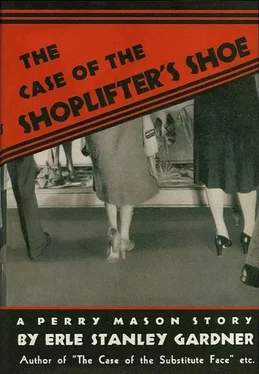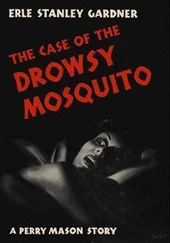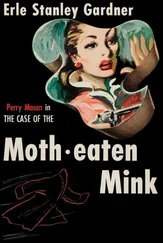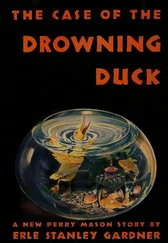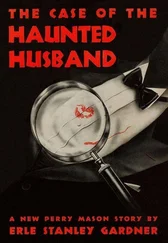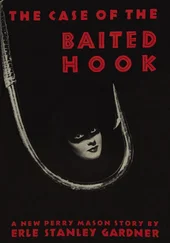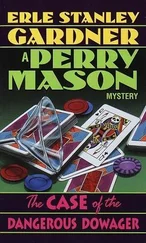Sergeant Holcomb identified it. He had been standing by the side of the autopsy surgeon when the bullet had been taken from the body of Austin Cullens. He had received this bullet from the doctor. He had handed this bullet to the witness, Hogan, for the purpose of making tests. He had been present at those tests. The fatal bullet had been fired from the gun which had been taken from Mrs. Breel’s handbag.
“Cross-examine,” Sampson said to Perry Mason.
“How long have you been attached to the homicide squad, Sergeant Holcomb?” Mason asked.
“Ten years,” Holcomb said.
“You’ve had considerable experience in working up murder cases in that time?”
“Naturally.”
“You know what to do when you enter a room where a homicide has been committed?”
“I think I do.”
“Do you go through the pockets of the corpse, Sergeant?”
“Not until the coroner gets there. We leave the body just the way it is until the coroner arrives.”
“And you did that with the body of Austin Cullens?”
“Yes.”
“And then you searched the pockets?”
“We did.”
“You found a chamois-skin belt on the corpse?”
“We did.”
“Were there some jewels in that belt?”
“There were a few jewels left in the belt,” Sergeant Holcomb said. “Mrs. Breel had taken the gems from front pockets of the chamois-skin belt and put them in her bag.”
“You don’t know, of your own knowledge, that Mrs. Breel did that, do you, Sergeant?”
“Well, I have a pretty good idea... As you said, I’ve been on Homicide for ten years, and I’m not so dumb.”
Judge Barnes said, “The Court, of its own motion, will strike out the remarks of the witness as to what Mrs. Breel must have done, as being a conclusion of the witness and not responsive to the question.”
“Can you remember what was in the pockets of the corpse?” Mason asked.
“I can by refreshing my recollection from notes I made at the time.”
“Do so,” Mason said. Sergeant Holcomb produced a memorandum book. “What was in the upper left-hand vest pocket of the corpse?” Mason asked.
“A fountain pen and a pocket comb.”
“What was in the left-hand hip pocket?”
“A handkerchief and a pen knife.”
“What was in the right-hand hip pocket?”
“Nothing.”
“Nothing?”
“That’s right. You heard what I said — nothing.”
“Nothing at all?”
Sergeant Holcomb said, “I don’t know how you can have a nothing, unless it’s a nothing at all. When I say nothing, Mr. Mason, I mean nothing.”
Mason said, “Let’s see, Sergeant, you were present at a post-mortem examination made by Dr. Frankel on the body of Austin Cullens, and immediately following that you were present at the postmortem made on the body of George Trent. Is that right?”
“That’s right.”
“You didn’t leave the room where the postmortem was conducted, from the time Dr. Frankel started to work on the body of Austin Cullens until he finished with the body of George Trent?”
“That’s right.”
“You received one bullet from Dr. Frankel which had been taken from the body of Austin Cullens?”
“Yes, sir.”
“Now, just to keep the records straight, Sergeant, let’s refer to the bullet which was taken from the body of Austin Cullens as the Cullens bullet, and the thirty-eight caliber revolver, which the witness Diggers says he found in the handbag of Sarah Breel, the defendant in this case, as the Breel gun. Do you understand that?”
“Yes, sir.”
“Now, what did you do with the Cullens bullet?”
“I put it in my left-hand vest pocket.”
“Now, a few minutes later you received from Dr. Frankel a bullet which had been taken from the body of George Trent, did you not?”
“Yes, sir.”
“Now, for the purpose of keeping the records straight, let’s refer to that as the Trent bullet. And, since it is claimed that that bullet was fired from a revolver found in the drawer of a desk in Trent’s office, we’ll refer to that gun as the Trent gun. Do you understand, Sergeant?”
“Certainly.”
“All right. Now what did you do with the Trent bullet?”
“I put that in my right-hand vest pocket.”
“Then what did you do?”
“Then I went at once to the ballistics department, where I had Mr. Hogan fire test shells from the gun.”
“How did it happen,” Mason asked affably, “that you got those bullets confused?”
“That I got what? ” Sergeant Holcomb roared, half rising from the witness chair. “I didn’t confuse any bullets.”
“I thought you did,” Mason said. “Didn’t you hand Hogan the Trent bullet to check with the Breel revolver?”
“I did no such thing.”
“I thought Hogan said you did.”
“Well, he didn’t,” Sergeant Holcomb said, sliding over to the extreme edge of the witness chair, in order to emphasize his remarks, “and,” he went on, his face flushed to a brick red, “any insinuation to that effect is a deliberate falsehood. Your...”
Sampson jumped to his feet to interrupt hastily, “That’s enough, Sergeant, I understand how you feel, but please remember your function here is only that of a witness. Any resentment you may feel for what you consider tactics of obstruction or confusion used by counsel, is to be kept out of the case. You will please be respectful in your answers to Mr. Mason’s questions.”
Judge Barnes said, impressively, “The witness is a police officer. He is undoubtedly familiar with courtroom procedure. He will answer questions, and refrain from any comments or recriminations.”
Sergeant Holcomb’s hands were clenched into fists, his eyes glittered dangerously, and his complexion was that of a man who has been holding his breath for several seconds.
“Proceed, Mr. Mason,” Judge Barnes said.
Mason inquired casually, “You handed Mr. Hogan the Trent bullet, and asked him to compare that bullet with the test bullet fired from the Breel revolver, didn’t you, Sergeant?”
“I did nothing of the sort,” Sergeant Holcomb said.
“Just what did you do, Sergeant?”
“I took the Trent bullet from my pocket and handed that to Hogan, and told him to compare it. I didn’t say with which gun. Hogan compared it with the test bullet from the Breel gun first. Naturally, the bullets didn’t match. He told me so, and I said, ‘Of course, they don’t. That isn’t the Cullens bullet, that’s the Trent bullet.’ So then he compared the Trent bullet with the test bullet from the Trent gun, and they matched. Then I handed Hogan the Cullens bullet, and he compared that with the test bullet from the Breel gun, and they matched. Now, those are the facts of the case, and you can’t mix me up on ‘em, Perry Mason! ”
Judge Barnes said sternly, “That will do, Sergeant Holcomb.”
Mason said, “Isn’t it a fact, Sergeant, that you confused those bullets? Didn’t you first hand Mr. Hogan the Trent bullet under the impression that it was the Cullens bullet?”
“No, sir,” Holcomb said, “I told you once, and I’m telling you again, and I’ll tell you a thousand times, that I put the Cullens bullet in my left vest pocket, and the Trent bullet in my right vest pocket.”
“But when you handed those bullets to the ballistics expert, you first took the bullet from your right waistcoat pocket, did you not?”
“Yes.”
“Why?”
“It’s natural for a person to do that when he’s right-handed,” Sergeant Holcomb said.
Mason smiled. “And, by the same token, Sergeant, and following the same line of reasoning, it’s natural for a right-handed person to put an object given him first in his right-hand pocket, and an object given him after that in his left-hand pocket, isn’t it?”
Читать дальше
